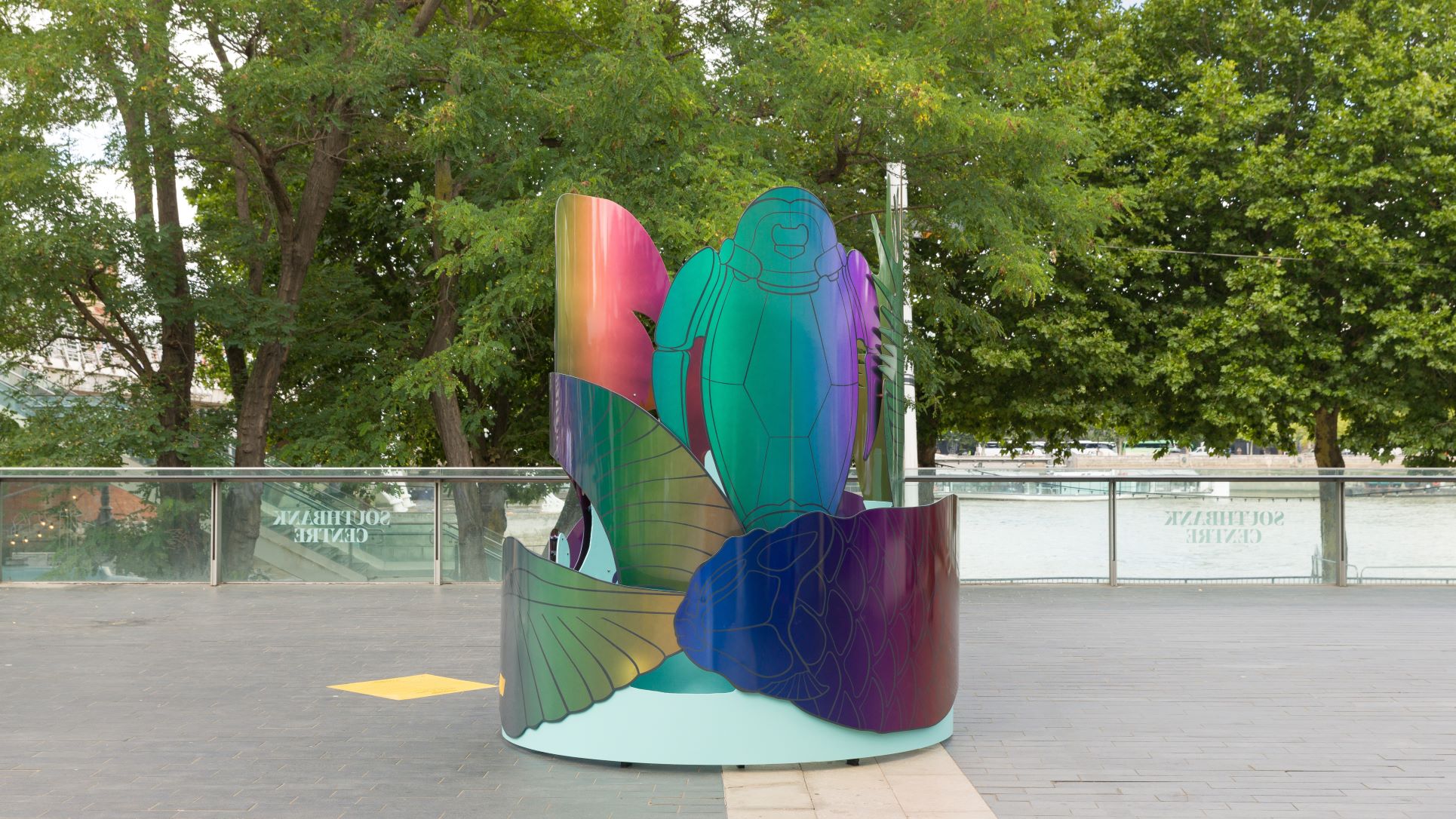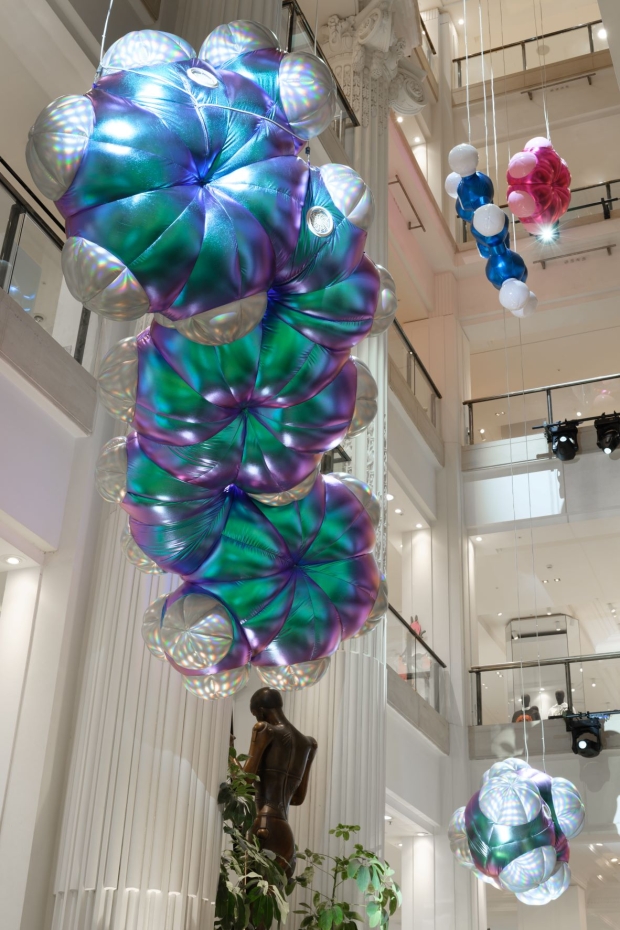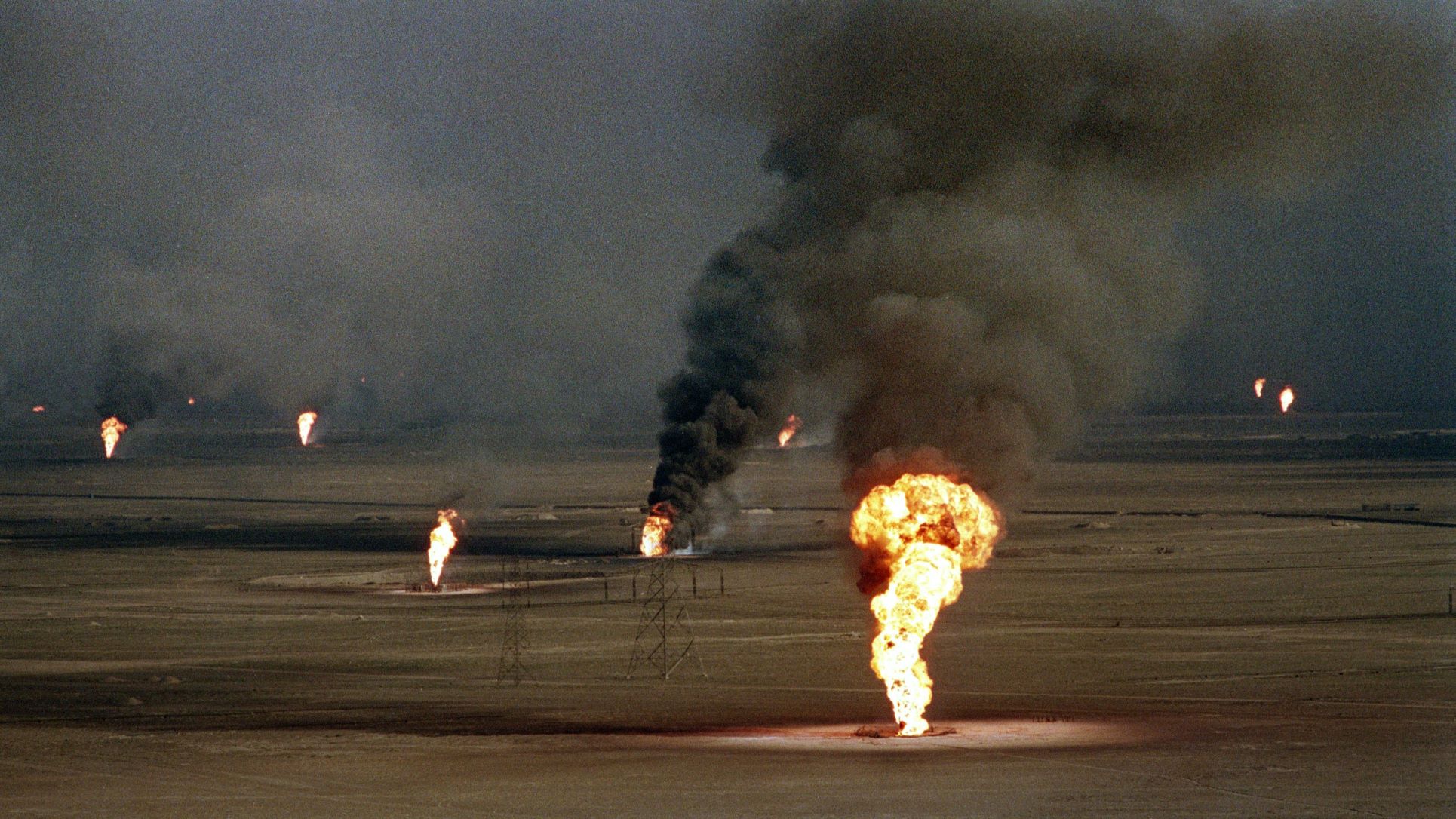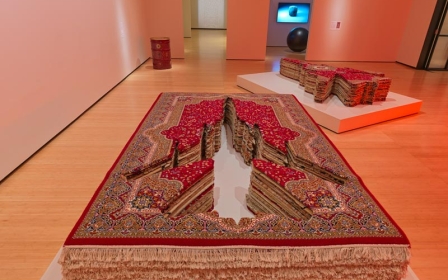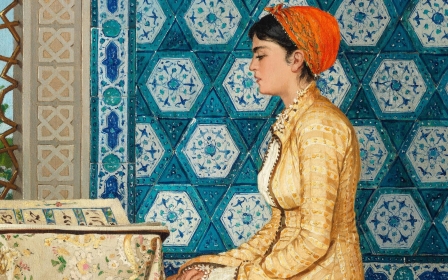Jurassic world: Kuwaiti artist Monira Al Qadiri on oil, war and Japanese manga
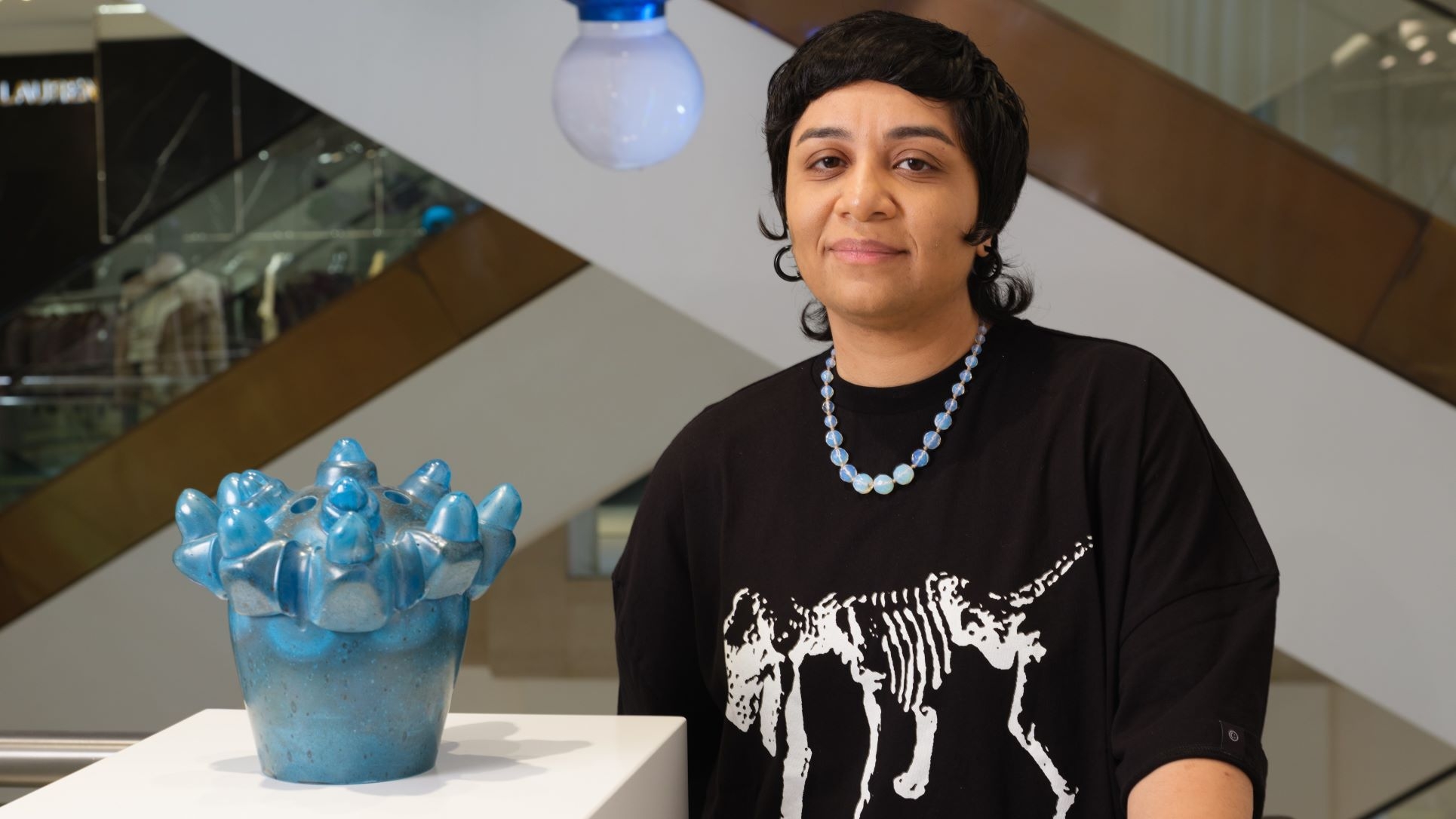
On the banks of the River Thames, under a leaden autumn sky, a towering, iridescent sculpture shimmers in the dwindling light.
As sunlight alights on its surface, the sculpture tricks the eye, morphing into a new rainbow-like incarnation each time it’s encircled.
The piece, Devonian, by the Kuwaiti visual artist Monira Al Qadiri, takes pride of place on the Riverside Terrace of London’s Southbank Centre, flanked by the iconic London Eye and Oxo Tower.
Comprising eight aluminium panels riveted together, the sculpture replicates the bodies of ancient sea creatures that lived millions of years ago, whose fossilised remains formed the basis of crude oil.
The sculpture takes its name from the county of Devon, an area of the UK, which along with its sister county Dorset, is famous for the red sandstone rich in the fossilised remains of these long-dead animals.
Al Qadiri had used automotive paint to recreate these creatures in the lustrous rainbow palette of the sea: turquoise, gold, emerald and violet emblazon the work, imparting an eerie, otherworldly quality.
“Art in public spaces is a whole science in itself,” explains Al Qadiri, from Houston, Texas, where she is exhibiting in a major new show “Refined Vision” at the Blaffer Art Museum.
“I didn’t want to make something difficult to understand. I wanted to make it accessible. The work [Devonian] is very colourful and has these phantasmagoric shapes, which lures members of the public, whatever their social class or age, to become interested in it and interact with it,” says Al Qadiri.
“The paints react very differently to the light. I like the fact that it is animated, that it constantly changes. I wanted to recreate the moment when all these creatures crystallised together to create the substance we know as oil.”
Although playful, the work also has a much more profound meaning, as Al Qadiri explains:
“It’s very colourful and fun, but I wanted to highlight that it takes billions of years to cook this substance from these animals and we just burn it in a car in a second. How absurd is that as a concept?
“It is so unsustainable that we choose to use this very strange material that we have to extract from the earth, which hurts the environment, and is made of these weird creatures that look like something out of science fiction.”
Oil, its history and its future
A short distance from the Southbank, on London’s Oxford Street, three of Al Qadiri’s artworks can be seen in the Selfridges department store’s Superfutures exhibition curated by Agnes Gryczkowska. The show brings together 13 artworks from a range of artists, imagining a series of alternative futures.
In Benzene Float (2022), an inflatable molecular model of the chemical compound benzene takes pride of place over the central escalator, bobbing languorously over shoppers’ heads as they ascend the store’s floors.
The work, painted in Al Qadiri’s trademark iridescent hues, comments on the omnipresence of this colourless, volatile and highly carcinogenic liquid, a natural component of petrol and diesel, in our everyday lives.
In the atrium area, on the third floor near the women’s designer outlets, Amorphous Solid Ghost (2017), a set of four hand-blown Murano glass sculptures in rainbow hues, are displayed in glass cases like an imperial monarch’s ill-gotten hoard.
The work, which replicates a series of oil drill heads, is a statement on the negative impact of fossil fuel extraction on the Earth.
Drill heads are a recurring theme for Al Qadiri - at the "The Milk of Dreams" exhibition showing at the Venice Biennale, her haunting display Orbital (2022) features replicas of drill heads hypnotically spinning, courtesy of a magnetic rotation platform in the base, resembling extraterrestrial spaceships with ominous intent.
The final installation displayed in the store, Deep Float (2017), is a bathtub sculpture where human hands claw their way out of a glistening tub of black liquid, reminding shoppers of an earlier use of oil in the sixth century BCE when it was used as a therapeutic spa treatment.
Al Qadiri’s work imagines the practice’s resurgence in the future, after the use of oil as an energy source has become obsolete.
At the heart of the artist’s practice is the history and future of crude oil; how the substance upended life socially, economically and culturally in the Gulf region, a region she knows well having grown up in Kuwait and lived there during the 1991 Gulf War.
With work in London, the aforementioned Biennale, a permanent installation (Chimera) in Dubai, and a series of new works on display in Houston, Texas, the 39-year-old artist is having a seminal moment confirmed by the award in October of the prestigious Fellbach Triennial Small Sculpture Prize 2022.
“It feels good to be recognised,” says Al Qadiri, humbly. “I’ve been making these works for a long time.”
‘The fragility of memory’
The Blaffer Art Museum has commissioned four new works from the artist, including Crude Eye, a haunting 10-minute film of a model of an oil refinery that Al Qadiri built in her studio and is projected several metres' tall.
There is also Seismic Song, a six-foot karaoke-singing dinosaur, which sings in an autotune voice - a technology developed by an oil engineer.
Jurassic Gauntlet consists of two animatronic drills that look like talons emerging out of a wall, and Onus, a model of a bird made of black glass, represents the environmental destruction that took place during the Gulf War.
The latter is “the most direct work about oil I’ve ever made”, says Al Qadiri, who explains the piece recalls when Iraqi troops set fire to the country’s oil wells as part of a scorched earth policy when they retreated from Kuwait in 1991.
“The whole landscape was black. The sky was black. Birds, fish, animals, all sorts of wildlife were covered in petroleum and these black birds covered in oil were dead in the ocean - you could see them everywhere,” says Al Qadiri, who was seven at the time of the invasion. “Everything was on fire for about a year, even our house was covered in black oil.”
Later, when she was studying in Japan, Al Qadiri recalls an incident in an advertising class when a professor “pulled out a picture of one of these oil-covered birds from Kuwait as an example of wartime propaganda”, stating that it was faked and obviously not real.
“I knew this was not true as I had seen it (the devastation) with my own eyes, but even I started to doubt myself.
“I decided to make these oil-covered birds out of glass because it represents the fragility of memory and the status of the post-truth world we now live in; that reality, even if experienced, is somehow suspect and questioned. It deals with heavy themes, it is beautiful but very tough to look at.”
Al Qadiri admits that to have a show in Houston, Texas, the oil capital of America, is “very radical”.
“I was told that you can’t spit here without touching someone who works in the oil industry. It’s exciting to be here - it might make some people uncomfortable, but I think it’s important for my work to be in these places in these contexts.
“When I show my work in other places, they have different impressions, and focus on the ecological aspect, but here it’s a more existential topic.”
Life after war
Of Kuwait and the war, Al Qadiri remembers her parents shielding her from the worst of it. Her mother Thuraya al-Baqsami is a famous painter. Al Qadiri remembers her and her sister Fatima (who is now a musician and has scored a number of her projects, including Crude Eye) growing up in a studio, drawing and painting for fun.
“We were just happy that we didn’t have school anymore - we could run around the house all day and paint. Everything seemed like a video game: we were the good guys; they were the bad guys. Obviously not having any food or electricity… but as children you don’t really understand anything, you don’t really know what was going on.”
Al Qadiri would lose herself in Japanese manga cartoons on television dubbed in Arabic. “It was a very colourful, magical place and as a child living through this horrible reality, I wanted to go there.”
The urge was so strong that Al Qadiri taught herself Japanese, eventually winning a scholarship and moving to Japan at the age of 16.
She attended three of the top art schools in Japan, Musashino Art University, Tama Art University, and eventually completed her PhD at Tokyo University of the Arts.
“Culturally,” she says, “it was like going to an alien planet, but at the same time my work is highly influenced by Japanese culture.”
Al Qadiri explains that the Japanese have a cult of ancestor worship, where you have a shrine to your ancestors in your home, “you talk to them and feed them, they are alive somehow”.
One impressionable moment for the artist was meeting a fellow student’s mother, who happened to be a ghost reader. “She started screaming when she saw me, as she said there were 40 ghosts of my ancestors stuck to my body, 40 bearded scary men. And they regarded me as the chief of their tribe,” laughs Al Qadiri. “The funny thing is, at the time, I was painting these bearded men.”
'Humour is a weapon, you can relay these very different subjects in a conservative society if you coat them in a sheen of humour'
- Monira Al Qadiri
Al Qadiri turned this episode into a theatre performance, Phantom Beard (2019), in which these “ancestors” are projected onto a screen behind her and she communes with them on stage. She cross-dresses throughout the performance, prompting the question of whether this was a way of linking the chameleon-like nature of oil with a more fluid gender identity?
Al Qadiri gives a prosaic answer. “It came out of the war. During the war, we were living in this patriarchal society, men were seen as heroic, but me, my mum and my sisters were stuck at home. I felt as a child that the only way to become a powerful person was to dress as a man. It was really this narcissistic urge to appear powerful.
“I’ve used cross-dressing in the past in performance. Initially, I thought people wouldn’t accept it and it would be censored. But because people thought it [Phantom Beard] was a comedy, they accepted it. In a way humour is a weapon, you can relay these very different subjects in a conservative society if you coat them in a sheen of humour.”
Connecting the pre-oil and post-oil worlds
The experience in Japan, after which Al Qadiri returned to Kuwait, got the artist thinking about her more recent ancestors, in particular her grandfather, Issa al-Qadiri, who was a singer on pearl-diving boats in the 1960s.
“I wanted to create a relationship between the pre- and post-oil world, using me and my grandfather as a microcosm of everything,” says Al Qadiri. “I am the quintessential post-oil baby and he is a representation of the history which existed before oil, that of diving for pearls which existed for hundreds, if not thousands, of years.”
Al Qadiri discovered that these pearl-diving expeditions were gruelling, with men undertaking exhausting 25-metre dives several times a day for little or no reward. Issa’s role as a singer was to keep spirits up on these trips, but even the songs, with the sailors using pots and pans as instruments, were harsh and guttural, reflecting the unforgiving environment.
“I felt that oil created this huge rupture in the historical narrative of Kuwait and I started to think how could I reclaim this history in a different way, so I started using the colour scheme of pearls and oil as a bond between the two historical epochs,” explains Al Qadiri.
“Pearls and oils have the same iridescence, they are just on the lighter and darker sides of the spectrum. But when oil is not used anymore, will the colour live on in a different way like a genie - from pearls to oil to something else?”
'I felt that oil created this huge rupture in the historical narrative of Kuwait'
- Monira Al Qadiri
The aesthetic that Al Qadiri imbues her artwork with - particularly the drill heads - is deliberate.
“The beauty is part of the seductive process, about the seduction of wealth. When you think about oil, you think about the enormous amount of wealth that it creates which blinds people to the destruction that these [extraction] tools wreak on the Earth. So it’s very much integral to my practice to have these opposing ideas in one form.”
Al Qadiri admits that for a place like Kuwait, which is so dependent on oil wealth, predicting an end to fossil fuel use is akin to suicide, but insists that these are conversations that need to take place.
“I’m trying to create these monuments for the age of oil. I want to eulogise it,” she says.
“It’s a freak time in history, and it’s created these levels of wealth and decadence that the world has never seen before, but at the same time it’s going to end, it is inevitable.
“We really have to think about diversifying beyond this thing to survive.”
Monira Al Qadiri’s Devonian at the Hayward Gallery on the Riverside Terrace runs until 6 November 2022
The Selfridges Superfutures exhibition ran from 14 July to 16 October 2022
The Milk of Dreams at the Venice Biennale runs until 27 November 2022
Monira Al Qadiri’s Refined Vision at the Blaffer Art Museum, Houston, Texas, is on show until 8 January 2023
To find out more about Monira al Qadiri’s work, visit her website at www.moniraalqadiri.com
Middle East Eye propose une couverture et une analyse indépendantes et incomparables du Moyen-Orient, de l’Afrique du Nord et d’autres régions du monde. Pour en savoir plus sur la reprise de ce contenu et les frais qui s’appliquent, veuillez remplir ce formulaire [en anglais]. Pour en savoir plus sur MEE, cliquez ici [en anglais].


